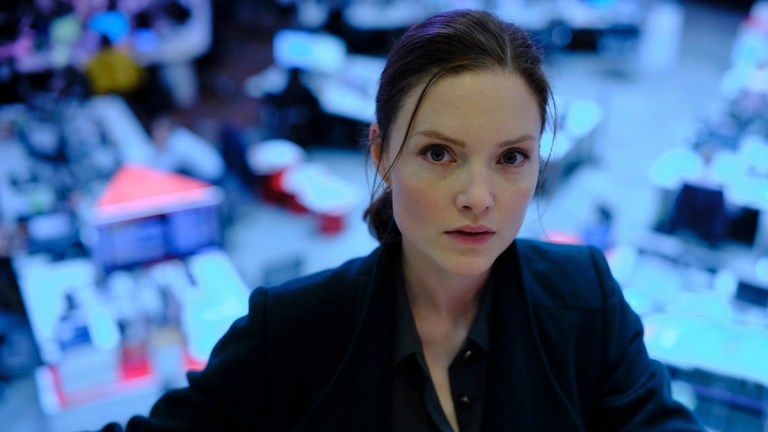The Capture May Feel Like Science-Fiction, But Real-Time Deepfake Tech is Here
Could BBC thriller The Capture’s real-time deepfakes actually happen?

Warning: contains spoilers for The Capture Series 2 Episodes 1-4.
The Capture series two, episode four ends on a cliffhanger that could have come straight from an episode of The Twilight Zone – a man answers the telephone in his hotel room and hears his own voice speaking back at him. It’s time they met face to face, other-him says, then there’s a ring at the door. He walks over and there on the video intercom is… him, his own face looking up at him and waiting to be buzzed inside.
What are we talking? Hallucination? Apparition? Clone? No, The Capture isn’t a fantasy or sci-fi, it’s a political thriller set (more or less) in the real world. This is technology, sufficiently advanced that, as Arthur C. Clarke might say, it’s indistinguishable from magic.
Series two started with a scene that looked supernatural on first sight: an assassination was carried out by what appeared to be an invisible killer. As seen via a CCTV feed, an apartment building’s automatic doors opened to no-one, followed by those of a lift, which climbed several floors apparently empty of passengers and deposited no-one in a corridor where a victim was shot dead through the viewer in his front door. The assassin? Unseen. Was it, as the cleaning lady suspected, a ghost? No. The killer was as real as the bullet, the gun and the victim. They’d been there all along, we’d just been stopped from seeing them. The CCTV footage had been hacked to mask their presence.
The Capture series one introduced viewers to the practice of “correction”. That’s when – to its defenders in the intelligence services – CCTV footage is fabricated to replicate crimes that they know happened but couldn’t otherwise prove happened in court. To its detractors including would-be whistle-blower DCI Rachel Carey (Holliday Grainger), correction is the state riding roughshod over the justice system and its citizens by falsifying evidence for its own ends. Goodbye to innocent until proven guilty, hello to guilty if it suits MI5, the CIA, the Chinese Ministry of State Security or the Russian Foreign Intelligence Service to ‘prove’ you guilty.
Correction is the global intelligence community’s dirty secret, says The Capture series two’s Home Secretary (Andy Nyman). No country can afford to expose it because everybody does it. That’s why, when a live Newsnight interview with Isaac Turner MP (Paapa Essiedu) is hacked and Turner is replaced by a real-time deepfake version of himself – a hyper-realistic computer-generated puppet for his enemies to make say and do whatever they want – the British government covers it up. If they were to cry foul play, they’d only reveal their own dubious practices.
Isaac Turner MP is the character we last saw confronted by his doppelganger at the end of episode four. His likeness has been digitally recreated using deepfake techniques multiple times in series two. As Britain’s Security Minister and head of the China Research Committee investigating a Chinese bid for a national facial recognition security contract, Turner’s digital puppet is a powerful thing to operate. Whoever’s pulling its strings (China? The CIA? Russia?) no longer has to blackmail politicians to steer them in a certain direction, they can simply put words into their digital mouths. Imagine.
Real-time deepfakes are already here. Thanks in large part to a grimy appetite for deepfake pornography – in which celebrities’ faces are digitally mapped onto those of sex performers at work – we have the technology. From TikTok influencers swapping their own faces for those of Hollywood stars for hijinks, it’s a small step to deepfake “camgirls”, in which porn-users will be able to interact online with a real sex worker sporting the mapped celeb face of their choice.
What’s available at present however, is apparently nothing like as slick it looks in The Capture. As reported on The Register, findings from Metaphysic.ai on real-time deepfake app DeepFaceLive showed that the subject’s head moving to the side is enough to derail a deepfake’s realism.
The consensus seems to be that it’s only a matter of time before the technology catches up. And who even needs to move their head to the side when they’re using a video conferencing service like say, Zoom? The static, front-on nature of such online video communication is a boon to deepfaker cybercriminals, who have already successfully committed financial fraud by cloning voices and duping employees into believing they’re talking to their company director. Forbes report here on a Hong Kong bank manager who transferred $35 million to fraudsters who did just that in 2020.
As reported by The Guardian in 2021, businesses are already having to develop systems to protect themselves from exploitation by real-time deepfake scams. While email remains the top method of fraudulently impersonating a company or member of staff online, voice cloning (as seen in series two, episode three of The Capture, when DCI Carey attempts to use her police radio to call for back-up and instead hears her own voice stating that the situation is under control) is already here. Tech security advisors are even warning companies that entirely fictional remote-working employees could soon be faked realistically enough to compromise business’ internal security.
Suddenly politician puppets on TV (and we’re not talking about Spitting Image) don’t seem all that ludicrous. And then the next time an MP has a car-crash Zoom TV interview, how long until the ‘I was deepfaked’ defence becomes as regular a cry as ‘fake news’?
The Capture Series Two concludes on Sunday the 11th and Monday the 12th of September at 9pm on BBC One.
